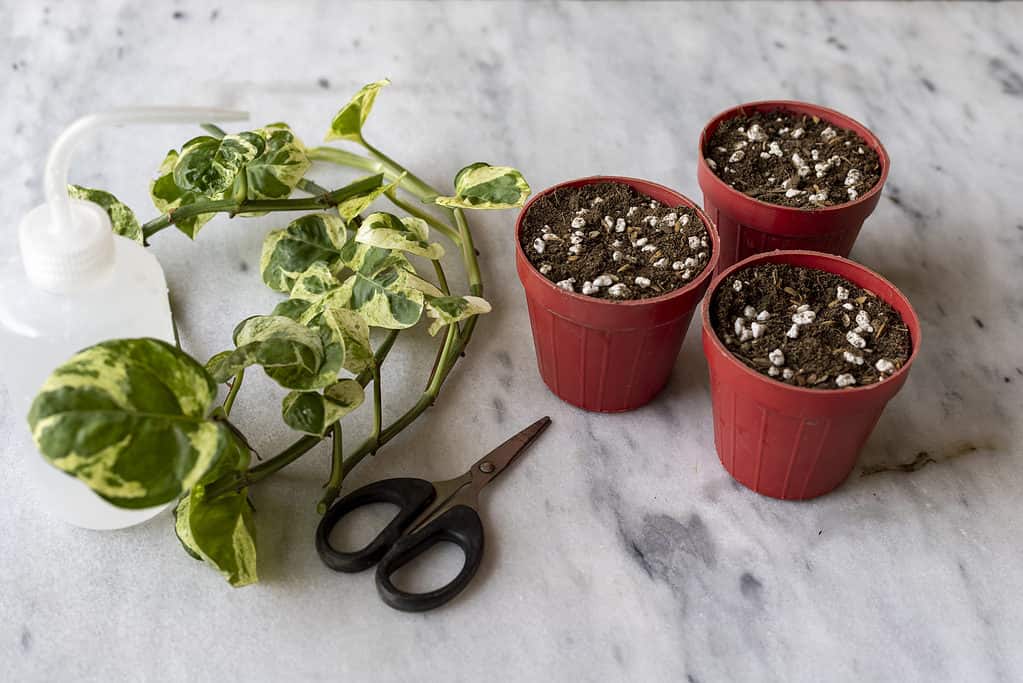For fans of the easy-to-grow houseplant, pothos, you’ll be delighted to know this plant is just as easy to propagate as it is to care for. You may be interested in pothos propagation to share new plants with friends, generate clones of a struggling plant, or expand your collection of a particular cultivar. Whatever your reason, the steps to propagate this lovely tropical vine are straightforward and achievable.
This guide will delve specifically into how to propagate pothos in water, a common method for this plant. We’ll discuss how pothos self-propagates naturally and then provide an easy step-by-step tutorial to help ensure your success.
Pothos: Botanical Classification and Natural Propagation

Pothos propagation can be done in various ways.
©iStock.com/Bilal photos
Native to the Solomon Island of the South Pacific, pothos (Epipremnum aureum) belongs to the Araceae family of flowering plants. If you study pothos, you may know that even though this plant is technically an angiosperm (flowering plant), it’s actually considered shy-flowering due to a deficiency in the hormone gibberellin. As such, pothos do not often flower, even in ideal natural settings. Instead, pothos tends to reproduce asexually through vegetative reproduction. Through this method of reproduction, pothos replicates, or clones, its genetic material when parts of the original plant break off and grow new roots.
Stems break off as this plant grows and climbs up trunks of jungle trees. These stems then drop to the ground, rooting into the moist soil and creating an entirely new plant that shares the same genetic information as the original plant. Since this is its main reproduction method, pothos is perfectly suited for propagation as a houseplant.
Propagating Pothos: Why Propagate in Water?
One of two main methods of cloning pothos from a cutting (the other being directly into a potting mix), propagating in water, allows you to watch the roots develop from the nodes of the stem. This method typically results in the roots forming faster. Plus, it’s exciting to witness the development. Additionally, since pothos is so naturally successful at vegetative reproduction, you won’t need to cover the cutting with rooting hormones. This makes pothos ideal for water propagation since rooting hormones don’t adhere well to the stem in water.
A downside of propagating pothos in water is that you must transplant the fragile roots into the soil during a vulnerable growth stage. Also, the plant may initially struggle to adjust from growing in water to growing in soil or a soil-less potting mix. However, as long as you carefully handle the plant and provide the nourishment and growing conditions it needs to thrive, your hardy pothos plant is bound to succeed.
Note that you should ideally wait until spring or summer to take cuttings from your pothos as this is your plant’s growing period, and roots will more easily and readily emerge.
Propagating Pothos in Water: 6 Easy Steps

It’s always exciting to notice the growth of your pothos during its propagation in water.
©TY Lim/Shutterstock.com
To get started, you’ll need to gather the necessary supplies. While collecting materials, you can also gather what you’ll need for potting your newly propagated plant. These items are:
- Plastic or glass jar
- Sterile scissors or pruning shears
- Pot
- Potting mix (soil or non-soil based)
- Liquid fertilizer
Once you have the required supplies, follow these six easy steps:
- Choose a healthy stem on your pothos with equally healthy foliage. Separate out a section about 6 inches long with multiple nodes (where the leaf stalk connects to the stem). Using your sterile snips, make a cut about 1/4 inch below the bottom node of the chosen section.
- With your sterile snips, cut off the plant’s bottom two to three leaves, leaving the bottom half of the stem bare. This is the section you’ll place into the water.
- Gently put your cutting in the jar and fill it with enough water to submerge the bare portion of the stem.
- Place the jar in a location with bright, indirect sunlight.
- Wait a matter of days up to about a month for root development. As you wait for your cutting to grow roots, you’ll want to make sure to change out the water once a week. Oxygen levels deplete in stagnant water, so you’re ensuring the cutting thrives by replacing it with fresh water weekly.
- Once roots grow to about 2-3 inches, plant your newly propagated pothos with a fresh, moist, well-draining potting mix. If the mix doesn’t contain them, you can add perlite, coconut coir, or sphagnum moss to aid in aeration and water drainage.
Up Next:
- How to Propagate Monstera Plants: 6 Simple Steps
- How to Propagate Croton Plants: 8 Easy Steps
- How to Propagate Spider Plants: 4 Easy Steps
The photo featured at the top of this post is © TY Lim/Shutterstock.com
Thank you for reading! Have some feedback for us? Contact the AZ Animals editorial team.






